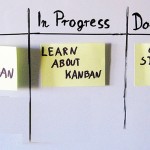
Are you having trouble juggling multiple projects? Does it seem like nothing is getting done? Does your task list grow longer and longer each passing day? These feelings are quite common and can often lead to burn-out. However, it doesn't have to be that way. In this article, I'll explain some simple and effective ways to manage multiple projects, conflicting priorities and a seemingly impossible workload.
At one time or another, all of us find ourselves in a position where we feel overwhelmed at work. You have a huge list of things to complete and every day more items get added to the list. So the list keeps growing and it feels like nothing is getting finished. Sound familiar?
The first thing you need to do is change the way you think about your workload. The mistake most people make is they constantly look at the large list and think to themselves, "I can't do all that in such a short timeframe." Thinking this way is the worst thing you can do, because your doubt and negativity will greatly decrease your productivity. If you think you can't, then you will be right. Instead, you should start the day by looking at your list and saying, "I'm going to get a lot done today." Once you have the right frame of mind, you will be prepared for productivity.
Next, you should have a process in place to manage your workload. The more complicated your workload is, the more important it is that you have a well-structured process in place to manage it.
Plan and prioritize
An important part of the process is to plan out and prioritize your workload. A spreadsheet or task management software can be very helpful, but you can also simply use sticky notes or a whiteboard. This step should not take a lot of time and ideally should only take you about 10-15 minutes a day.
Step 1. Create a list
This step may seem trivial, but it is important that you have a thorough task list before prioritizing your tasks. Your list can be fairly high-level or very detailed. It is most effective when each item can be performed in less than a day and preferably in chunks of 1 hour or less.
Step 2. Estimate the level of effort
Next to each task item in your list, write down an estimate for how long that task will take you to complete. A ballpark estimate is all you need; don't ponder on it for a long time. With practice you'll get more accurate at estimating.
Step 3. Urgency Assessment
Take a close look at your task items and ask yourself which items are the most urgent. It's best to only choose a few (2 or 3) highly urgent items, even if they all seem to be top priority. Highlight the few highest priority items in your list.
Step 4. Sort your list
Now it's time to sort your list. If you have urgent items that need to be completed very quickly, those will obviously go to the top of the list. Another consideration is level of effort. Typically a large majority of your task list will be relatively small tasks. One very effective method is to work on the quick and easy tasks first. At the very least you'll feel like you're getting a lot of stuff done. That alone will improve your morale and give you a productivity boost.
Learn to manage your manager

So once you have your prioritized task list, you should show it to your manager and confirm that your list of priorities matches theirs. In general, the more your manager knows about what you're working on and how long it will likely take, the better off you'll be. Of course, you should deliver what you promise. One important note here, the higher a person is within an organization, the less detailed information they need to see. So if you're working for a senior executive, keep it short and sweet. As for frequency, it depends on the type of work you're doing. Most people choose to do this on a weekly basis. However, if you have a lot of small tasks then you may want to meet with your manager for 10 minutes every day to review your list. If you're working on much larger task items, then monthly may suffice. In general, it is better to err on the side of meeting too frequently. There's nothing wrong with saying "nothing new to report" or quickly summarizing where things are at.
Focus on one thing at a time
Focusing your full attention on one task at a time is by far the most important thing you can do to increase your productivity and get things done. The biggest mistake people make is trying to do several things at once. The human brain is simply not designed to multi-task. Just try to pat your head and rub your belly at the same time. An article by Jon Hamilton goes much deeper into this topic, but the point is: multi-tasking is bad.
One key reason multi-tasking is so unproductive is it takes the brain time to switch tasks and get into a "productivity rhythm." Switching back and forth between multiple tasks is a huge productivity drain. So do yourself a favor and avoid multi-tasking. Stay organized and work on one task item at a time through to completion.
Kanban Board

Use time blocks
One trick to increase your productivity and assist with focusing on one task at a time is to use time blocks. Time blocks are pre-specified periods of time that you set aside to work on specific tasks. A well-known example of this is how professors have "office hours" where students can visit them. It allows professors to avoid being bothered all day long with students coming in asking questions, thus they are able to be productive the rest of the day and still satisfy the students' needs.
If you find that you are always getting disrupted and it's affecting your performance, then blocking out an hour or more each day for specific tasks can be a great technique to boost your productivity.
Manage your stress
We all have some amount of stress in our daily lives, but constantly having a large task list can really increase your stress levels. There are several things you can do to reduce your stress level. Employing the tactics mentioned above is a great start.
It is also important to take frequent breaks throughout the day. It's even better if you take the breaks at regular intervals, such as hourly, to create a routine. Even if you just stand up and stretch for a few seconds or close your eyes and take a few deep breaths, taking frequent small breaks throughout the day will greatly reduce your stress levels and will boost your productivity.
In addition, changing the way you look at your workload can help. When faced with a seemingly impossible workload, it's easy to get down on yourself. However, at the end of the day all you need to do is ask yourself one question. "Was that the best I can do?" If you can honestly answer yes to that question, then you should be able to leave the office knowing that you did your best. As Tony Horton from P90X says, "do your best and forget the rest."
Finish it already

Conclusion
If you feel like you're stuck in a never-ending battle with your task list, there is a simple solution. You start by planning and prioritizing your task list. Next you work closely with your manager to gain consensus and set expectations. Remember to always focus on one thing at a time to maximize your productivity and take breaks to reduce your stress. Wherever possible, take advantage of some productivity tools, such as Kanban boards and time blocks. Finally, make sure you're finishing tasks rather than letting them linger. If you follow these simple techniques and continue to work hard, you will be happier, more productive and your manager will take notice.

 New Horizons
New Horizons
 Project Management Academy
Project Management Academy
 Six Sigma Online
Six Sigma Online
 TCM Security
TCM Security
 TRACOM
TRACOM
 Velopi
Velopi
 Watermark Learning
Watermark Learning
 Login
Login





 New Horizons
New Horizons
 Project Management Academy
Project Management Academy
 Velopi
Velopi
 Six Sigma Online
Six Sigma Online
 TCM Security
TCM Security
 TRACOM
TRACOM
 Watermark Learning
Watermark Learning